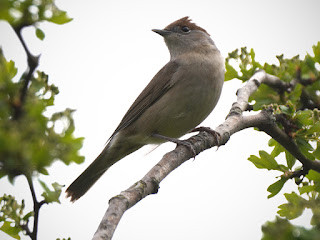A Blackcap sang in in a wind-tossed oak beside the Long Water.
A female perched in a hawthorn on the other side of the lake.
A Wheatear unexpectedly turned up on the grass near the Queen's Temple. There's no action at all in this video, but it's good to see a Wheatear in the park, as they don't visit very often. It stayed on the grass till it was frightened away by a dog.
A Robin sang near the Henry Moore sculpture.
A Jay stared from a sapling, waiting for a peanut.
You never know where a Great Spotted Woodpecker will turn up. This one was calling in a plane tree near the Hyde Park bandstand.
But there was no sign of the Tawny Owl today, though I visited his tree several times.
Great Crested Grebes were dancing again. This time I got them properly in focus.
Neil found two new Coot chicks from the nest just north of Peter Pan, and sent this pleasing picture. Their parents put them on a fallen tree branch close in to the edge, a safe place which they have successfully used for previous broods.
The Moorhen that was alone in the Dell and has now been joined by another is a male, and has recovered his mate from last year with whom he had a single surviving young one. Andrea the gardener who works in the Dell knows them individually, and told me the story. The female who has just returned is his second mate. She and her young one had been ousted by a third female, with whom the unfaithful male stayed until recently, when mate number two returned and chased her off. This is the male, walking casually up the little waterfall without bothering to use his wings.
The male Mute Swans at the island were still circling each other, wings raised in threat, to assert dominance. The display stayed peaceful until one of them started turning the other way, bringing them face to face and starting a scuffle.
The dominant male swan on the Long Water tired of having a Cormorant standing on his nesting island and chased it away.
Amazingly, the Mallard at the east end of the Serpentine still has six ducklings.
They dashed around catching midges. Growing ducklings need extra protein in their diet. We just hope they get a chance to grow.
In the Rose Garden, a female Hairy-Footed Flower Bee was visiting all the yellow flowers, a wallflower here and also polyanthus.
A male was going to the red flowers, in this case a wallflower.
A Common Dronefly landed on a yellow polyanthus.
Tom was at Rainham Marshes, where he got two fine pictures: the elusive Cetti's Warbler ...
... and a female Whitethroat.
I plan to go to Rainham tomorrow.




%202022%201.jpg)





%202022%201a.jpg)
%202022%201a.jpg)
Congratulations on the Wheateater! It's such a lovely hard to see bird. In don't know over there, but in Spain they tend to prefer degraded habitats, such as abandoned quarries.
ReplyDeleteNo Tawny Owl today, but the video of the dancing Grebes more than makes up for it.
"Synchronised threat" ought to be an Olympic sport. I'd watch the heck out of it.
It's a Wheatear because it has a white arse. Seriously.
DeleteGood for you to get a Wheatear. There's been an excellent passage of this species the last 2 days across London with at least 40 each day. I found 2 locally at Warren Farm on Monday & yesterday 6-8 birds. When we arrived there was a male with 3 females. A bit later as we left there were still 4 birds, but now 3 males & 1 female, so perhaps two groups of 4 but at least 6 individuals.
ReplyDeleteYour dronefly can't be Tapered Dronefly as that species has extensively orange front & mid tarsi (dark in your photo) so is Common Dronefly, Eristalis tenax.
Thanks for the correction. The sharp marks on its abdomen made me think it was Tapered, but I should have checked more carefully.
Delete